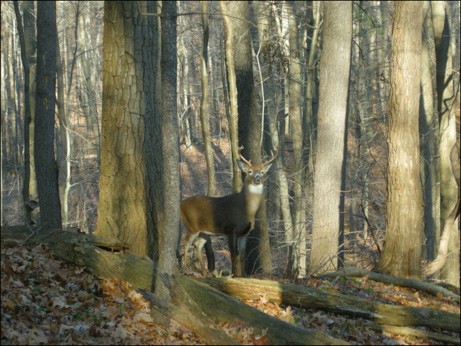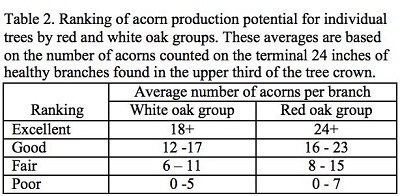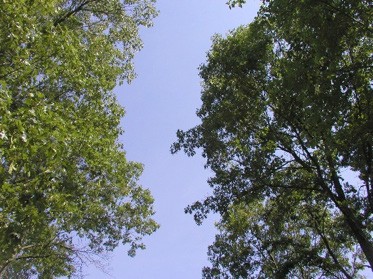AgEBB-MU CAFNR Extension
Green Horizons
Volume 21, Number 3
Fall 2017
Agroforestry
"Shooting a Double": Managing Oaks for Acorn and Timber Production
By Hank Stelzer| MU Extension - School of Natural Resources
I fondly remember bird hunting with my dad. Clear, crisp autumn days made especially memorable seeing the satisfaction on his face when he "shot a double", bagging two birds with one shot!
Flash forward to just the other day when I encountered a friend of mine, an avid deer hunter, coming back from a day of scouting his woodlands for the upcoming harvest season. His beaming countenance reminded me of my dad.
 |
Releasing high-quality oak trees from neighboring trees can lead to an increase in wood volume and acorn production. |
No. He did not take any deer out of season. His joy came from surveying the acorn crop an oak stand on his property he has been managing the past couple of years. Through his management efforts, he has "shot a double"; growing high-value timber and high-value food for wildlife!
Any landowner can do the same thing. For starters, do not try to do too much too fast. Many folks I know get easily discouraged trying to manage their entire property all at once. Think small and concentrate your effort on those acres of your property better able to respond to management. I am talking about north- and east-facing woodland slopes. On these sites, the soil tends to be deeper, moister, and more fertile.
The microclimate is cooler and less stressful on tree growth. The result is potentially bigger trees (more wood) and larger crowns (more acorns).
Oaks are one of the most important and abundant hardwood trees found in Missouri's forest. Besides producing high-quality wood products, oak acorns (along with nuts from hickory and walnut trees) provide an important food source called hard mast.
This hard mast is not only used by deer, but also by wild turkeys, squirrels, and wood ducks. Their widespread occurrence, palatability, nutritional value, and availability during the fall and winter months make acorns and excellent source of needed energy.
 |
Big oak trees with straight trunks are relatively easy for even a novice landowner to identify. But, what about a regular producer of acorns? The only way to know for sure which trees are the best producers is to check the acorn production over three to five years.
When walking through your woodland, note the trees that seem to produce in an "off " year. These trees will likely yield the most acorns over the long run. If you do not want to wait three to five years, you can get a rough estimate of the acorn-producing capacity of individual trees by observing in a single year in which there is a good crop.
Releasing high-quality oak trees from neighboring trees can lead to an increase in wood volume and acorn production.
Not every oak tree in your woodland stand will be a 'timber' tree and a good acorn producer. Sometimes, you will have to make tough choices. That is where the advice of a professional forester comes in handy. He or she can evaluate an individual tree's timber potential and its relationship with other trees in the stand to maintain proper spacing and species diversity. That information, coupled with your mast (acorn) records will help you make the final call as to which trees to keep in the stand.
 |
Once you have identified which trees to keep, the next step is to conduct a 'crop tree release'. This is where you remove neighboring trees to expose the crown of your crop tree to full sunlight on all sides. This thinning facilitates the expansion and density of branches within the crown. Increasing the density of branches within the crown not only increases the potential production of acorns, but it also allows the tree to produce more wood at a faster rate.
It is just like what happens when you weed a garden. Removing weeds and smaller tomato plants enables those remaining plants to not only grow bigger, but also produce more tomatoes!
Nineteen species of oaks are found in Missouri.
They are divided into two groups: the red (or black) oak species and the white oak species. (Table 1).
Acorns of the red oak group take two growing seasons to mature and are bitter because they are high in tannic acid. White oak acorns are less bitter and mature in one growing season.
The best time to observe and rank trees for their potential acorn production is from mid- to late-August before acorns are consumed by a variety of insects and wildlife. Acorns can be easily seen through binoculars on bright, sunny days when they are silhouetted against the sky. Table 2 provides some general criteria for ranking an individual tree's acorn production.
 |
Removing competition of neighboring trees provides more sunlight to the crop tree. |
For more information on managing your woodland for timber and wildlife, check out these MU Extension Guides:
MU Guide 9414: Managing oaks for acorn production to benefit wildlife in Missouri.
MU Guide 9415: Integrating woodland and wildlife management practices on your property.
